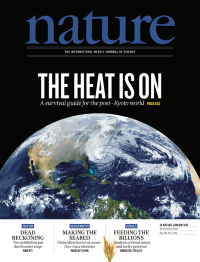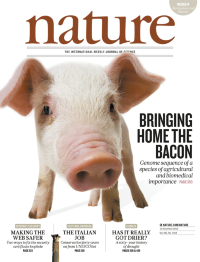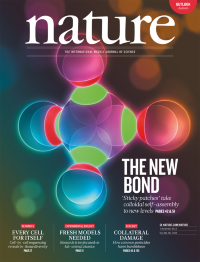Volume 491
-
No. 7426 29 November 2012
Under the Kyoto Protocol, 37 industrialized nations and the European Union pledged to reduce their greenhouse-gas emissions by 5% measured against 1990 levels by the end of 2012. As the first commitment period of the protocol draws to a conclusion, we take stock of just what has been achieved by a treaty that has patently failed in its main objective, and ask what can be done in the next decades to reboot the cause of curbing greenhouse-gas emissions. Cover: Hurricane Sandy from space/NASA GOES Project
-
No. 7425 22 November 2012
The modern human lineage appeared in Africa between 100,000 and 200,000 years ago, but the roots of modern human technology are much less clearly defined. Curtis Marean and colleagues describe a previously unrecognized advanced stone tool technology from Pinnacle Point in South Africa, dating back to around 71,000 years ago. Previously observed signs of such activity have been less definitive, seeming to appear and disappear � perhaps because of poor sampling � but the current work indicates that these tools persisted for some 11,000 years. The technology is dominated by heat-treated stone bladelets� that are thought to have been components of composite tools. The technology provides strong evidence for advanced projectile weapons such as spearthrowers, or even bows and arrows. The authors speculate that weapons made using such bladelets may have been pivotal to the success of modern humans as they left Africa and encountered Neanderthals. Cover art by Erich Fisher.
Nature Outlook
-
No. 7424 15 November 2012
The domestic pig (Sus scrofa) is an important livestock species, its genome shaped by thousands of years of domestication and, latterly, sophisticated breeding practices. A high-quality draft genome sequence for a female domestic Duroc pig is published in this issue of Nature, under the auspices of the Swine Genome Sequencing Consortium. Comparisons of the genomes of wild and domestic pigs shed light on the evolutionary relationship between European and Asian wild boars, and reveal the rapid evolution of genes involved in the immune response and in olfaction. The authors identify many possible disease-causing gene variants, increasing the potential of the pig as a biomedical model, and present a detailed analysis of endogenous porcine retroviruses, knowledge of which is important for the possible use of pigs in xenotransplantation. Cover: Mike Kemp, Rubberball,Getty Images/ Pompeii: Ren Mattes, Hemis, Corbis
Insight
-
No. 7422 1 November 2012
Imaging through opaque, light-scattering layers is an important capability in many fields, including nanotechnology and the biosciences. Several promising methods are being developed, but typically involve invasive procedures such a placing a detector or nonlinear material behind the scattering layer. Jacopo Bertolotti et al. now demonstrate a non-invasive imaging procedure that makes use of correlations in the speckled intensity pattern that is produced when laser light passes through a scattering medium. Fluorescent micrometre-sized objects obscured by scattering layers can be imaged by measuring total fluorescence at several different angles of laser incidence and by using an iterative algorithm that disentangles the spatial information of the object and the speckle pattern. The authors successfully construct detailed images of cell-sized fluorescent objects hidden six millimetres behind scattering layers, and a complex biological sample sandwiched between two opaque screens. Cover graphic by Cameron Slayden/Cosmocyte.
Nature Outlook





